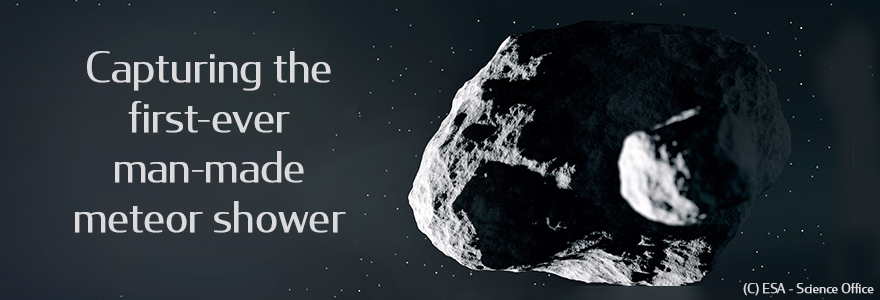Capturing the first-ever man-made meteor shower

Over a century ago, Oscar Wilde wrote about life imitating art; 22 years ago, many of the world’s scientifically-inclined raised their eyebrows at Armageddon – the blockbuster depicting a team of roughneck-cum-astronauts blowing up a cataclysmic asteroid headed to Earth. Regardless of whether Armageddon should be considered art, NASA’s upcoming DART mission sure does mirror it in many ways. DART is a planetary defense mission testing the possibility of deflecting an Earth-bound asteroid using a one-way spacecraft. The target asteroid is Didymos, which orbits the sun, and passes within about six million kilometres of Earth every 20 years or so. “The relatively close proximity of Didymos means that some of the extensive debris field, which will occur upon collision, may end up falling to Earth,” explains Paul Wiegert of the Department of Physics and Astronomy at Western University. The expected amount of debris to reach our planet is minuscule – it may not even survive the scorching trip through the atmosphere; but whatever does arrive will present a most unique opportunity to study the first-ever manmade meteor shower.
Wiegert and his colleagues in Western’s Meteor Physics Group will be tracking the debris field once it begins heading towards us. Making use of a network of telescope and radar stations set up across Ontario, Wiegert will be able to track even millimeter-sized fragments of rock as they hurtle to Earth. The wavelengths of light emitted from the debris as it burns in our atmosphere can tell the Group what chemical components are present in Didymos.
“What’s exciting about this debris, specifically, is that it comes from an identified asteroid. This is unusual: we rarely know exactly where any particular meteor comes from. Knowing about the meteors’ geology gives a completely new dimension in our understanding of the consequences of rocky explosions in space” tells Wiegert. The way in which material is ejected from an explosion is partially dictated by the mineral composition of the asteroid itself.
Future engagements with rocky space bodies, whether it be for planetary defense or asteroid mining will artificially produce fields of debris in space; the DART mission will be the first to give us an understanding of the impacts of our activities.
DART Impact Simulations, Wiegert 2020
Simulation of the debris from the DART (Demonstration for Autonomous Rendezvous Technology) spacecraft impact. From Wiegert (2020), On the Delivery of DART-ejected Material from Asteroid (65803) Didymos to Earth, Planetary Science Journal, 1, 3.
Simulation of the debris from the DART (Demonstration for Autonomous Rendezvous Technology) spacecraft impact. From Wiegert (2020), On the Delivery of DART-ejected Material from Asteroid (65803) Didymos to Earth, Planetary Science Journal, 1, 3.
“The more we have satellites and spacecraft and the more we venture into space for economic activities, the greater the consequences of these artificially-created debris fields,” says Wiegert. Impacts into bodies orbiting the sun, like Didymos, create debris that travels at up to 40 kilometres per second. Travelling at that speed, even minuscule particles can cause catastrophic damage to our assets in space. “We already know that naturally-occurring meteor showers can imperil telecommunications and defense satellites,” says Wiegert. “Future spacecraft will have to navigate the debris of our own creation, making it all the more important to understand how missions, like DART, will pollute the space environment.”
NASA missions, and others by governmental agencies around the world, make a vast amount of data public. It is this transparency that allows for researchers like Wiegert to build on the core mission, giving us an understanding far beyond the scope of NASA’s own interests. Directly behind the DART spacecraft will be Hera, a European Space Agency (ESA) craft investigating the immediate debris field as it emanates from the explosion. Western’s Meteor Physics Group will have to wait a few days before that debris comes close to Earth. When it does, their research will give essential insight into the consequences of human activity in outer space.

